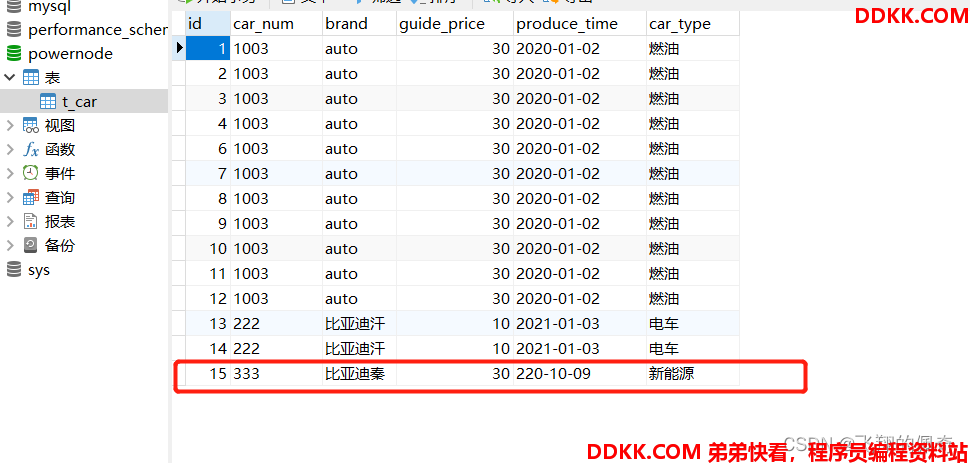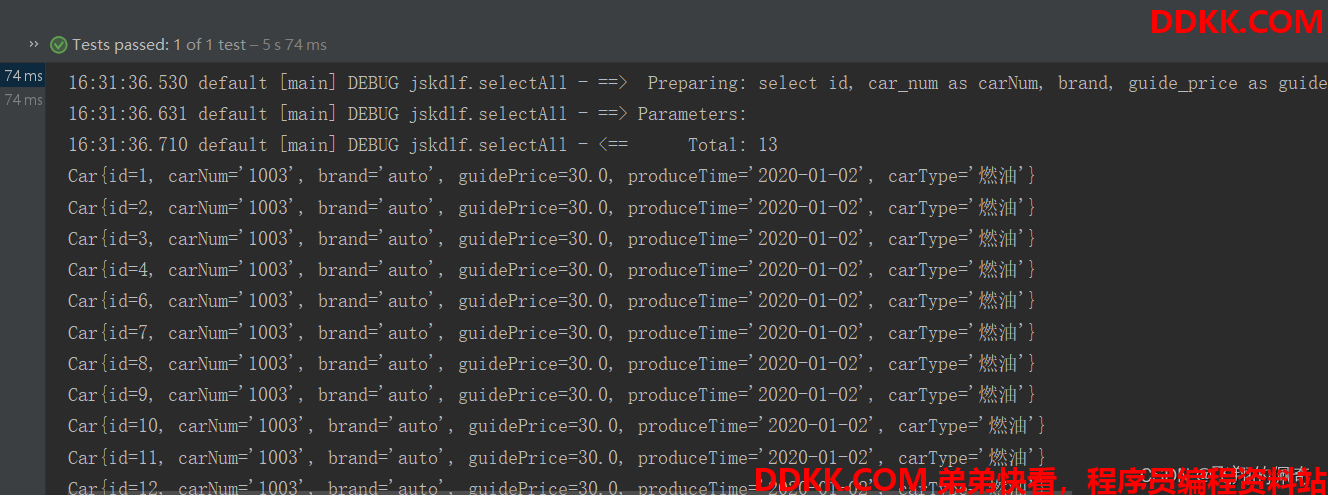一、准备工作
1、引入maven依赖
<dependencies>
<!--junit测试类-->
<dependency>
<groupId>junit</groupId>
<artifactId>junit</artifactId>
<version>4.11</version>
<scope>test</scope>
</dependency>
<!--mybatis依赖-->
<dependency>
<groupId>org.mybatis</groupId>
<artifactId>mybatis</artifactId>
<version>3.5.10</version>
</dependency>
<!--数据库驱动-->
<dependency>
<groupId>mysql</groupId>
<artifactId>mysql-connector-java</artifactId>
<version>8.0.30</version>
</dependency>
<!--引入logback日志框架依赖,这个日志框架实现了slf4j规范-->
<dependency>
<groupId>ch.qos.logback</groupId>
<artifactId>logback-classic</artifactId>
<version>1.2.11</version>
</dependency>
</dependencies>
2、开发工具类 SqlSessionUtil
作用:
1、SqlSessionUtil,方便用来获取SqlSession对象
2、避免多次重复创建SqlSessionFactory 对象,
因为一个环境下,只需要创建一个SqlSessionFactory
package com.powernode.util;
import org.apache.ibatis.io.Resources;
import org.apache.ibatis.session.SqlSession;
import org.apache.ibatis.session.SqlSessionFactory;
import org.apache.ibatis.session.SqlSessionFactoryBuilder;
import java.io.IOException;
public class SqlSessionUtil {
private SqlSessionUtil(){
};
private static SqlSessionFactory sqlSessionFactory;
static {
try {
sqlSessionFactory = new SqlSessionFactoryBuilder().build(Resources.getResourceAsStream("mybatis-config.xml"));
} catch (IOException e) {
e.printStackTrace();
}
}
/**
* 获取会话对象,
* @return
*/
public static SqlSession openSqlSession(){
return sqlSessionFactory.openSession();
}
}
3、准备 mybatis-config.xml文件
在resources目录下,添加mybatis-config.xml文件
<?xml version="1.0" encoding="UTF-8" ?>
<!DOCTYPE configuration
PUBLIC "-//mybatis.org//DTD Config 3.0//EN"
"http://mybatis.org/dtd/mybatis-3-config.dtd">
<configuration>
<environments default="development">
<environment id="development">
<transactionManager type="JDBC"/>
<dataSource type="POOLED">
<property name="driver" value="com.mysql.cj.jdbc.Driver"/>
<property name="url" value="jdbc:mysql://localhost:3306/powernode?useUnicode=true&characterEncoding=utf-8"/>
<property name="username" value="root"/>
<property name="password" value="root"/>
</dataSource>
</environment>
</environments>
<mappers>
<mapper resource="com/CarMapper.xml"/>
</mappers>
</configuration>
4、准备日志文件logback.xml
<?xml version="1.0" encoding="UTF-8"?>
<configuration debug="false">
<appender name="STDOUT" class="ch.qos.logback.core.ConsoleAppender">
<encoder class="ch.qos.logback.classic.encoder.PatternLayoutEncoder">
<pattern>%d{HH:mm:ss.SSS} %contextName [%thread] %-5level %logger{36} - %msg%n
</pattern>
</encoder>
</appender>
<logger name="com.apache.ibatis" level="TRACE"/>
<logger name="java.sql.Connection" level="DEBUG"/>
<logger name="java.sql.Statement" level="DEBUG"/>
<logger name="java.sql.PreparedStatement" level="DEBUG"/>
<root level="DEBUG">
<appender-ref ref="STDOUT" />
<appender-ref ref="FILE" />
</root>
</configuration>
二、INSERT 功能
1、JDBC和mybatis占位符对比
JDBC的代码是怎么写的?
string sql ="insert into t_car(id,car_num,brand,guide_price,produce_time,car_type) values(null,?,?,?,?,?)"; ps.setstring(1,xxx); ps.setstring(2, yyy);
....
在JDBC当中占位符采用的是?
在mybatis当中不能使用?占位符,必须使用{} 来代替JDBC当中的 ?#{} 和 JDBC当中的 ? 是等效的。
2、java程序中使用Map可以给SQL语句的占位符传值:
Map<String, Object> map = new HashMap<>();
map.put("k1","1111");
map.put("k2","比亚迪汉");
map.put("k3",10.0);
map.put("k4","2020-11-11");
map.put("k5","电车");
xml文件写法
insert into t car(id.car_num.brandquide priceproduce_timecartype)values(null,#{k1},#{k2}.#{k3}.#{k4}.#{k5})
注意:#{这里写什么?写map集合的key,如果key不存在,获取的是null}
一般map集合的key起名的时候要见名知意。
map.put("carNum","1111");
map.put("brand","比亚迪汉2");
map.put("guidePrice",10.0);
map.put("produceTime","2020-11-11");
map.put("carType","电车");
insert into t car(id,car_num,brand,guide_price,produce_time,car_type
values(null,#{carNum},#{brand},#fauidePrice},#{produceTime},#{carType})
3、java程序中使用POJO类给SQL语句的占位符传值
java程序中使用POJO类给SQL语句的占位符传值:
Carcar =new Car(null,“3333”,“比亚迪秦”,30.0,“2020-11-11”,“新能源”);
注意:占位符#{},大括号里面写:pojo类的属性名
insert into t_car(id,car_num,brand,guide_price,produce_time,car_type)
values(null.#{carNum}.#{brand}.#{quidePrice}.#{produceTime},#{carType}
把SQL语句写成这个德行:
insert into t_car(id,car_num,brand,guide_price,produce_time,car_type)
values(null,#{xyz},#{brand},#{guidePrice},#{produceTime},#{carType})
出现了什么问题呢?
There is no getter for property named 'xyz’ in 'class com.powernode.mybatis.pojo.Car mybatis去找:Car类中的getXyz()方法去了。没找到。报错了。
怎么解决的?
可以在Car类中提供一个getxyz()方法。这样问题就解决了。
通过这个测试,得出一个结论:
严格意义上来说:如果使用POJO对象传递值的话,#{}这个大括号中到底写什么?
写的是get方法的方法名去掉get,然后将剩下的单词首字母小写,然后放进去。
例如:getUsername() -->{username}例如:getEmail() -->{email}
也就是说mybatis在底层给?传值的时候,先要获取值,怎么获取的?
调用了pojo对象的get方法。例如:car.getCarNum(),car.getCarType(),car.getBrand()
完整的代码:
pojo实体类 Car
package com.powernode.pojo;
public class Car {
private Long id;
private String carNum;
private String brand;
private Double guidePrice;
private String produceTime;
private String carType;
public Car(Long id, String carNum, String brand, Double guidePrice, String produceTime, String carType) {
this.id = id;
this.carNum = carNum;
this.brand = brand;
this.guidePrice = guidePrice;
this.produceTime = produceTime;
this.carType = carType;
}
public Long getId() {
return id;
}
public void setId(Long id) {
this.id = id;
}
public String getCarNum() {
return carNum;
}
public void setCarNum(String carNum) {
this.carNum = carNum;
}
public String getBrand() {
return brand;
}
public void setBrand(String brand) {
this.brand = brand;
}
public Double getGuidePrice() {
return guidePrice;
}
public void setGuidePrice(Double guidePrice) {
this.guidePrice = guidePrice;
}
public String getProduceTime() {
return produceTime;
}
public void setProduceTime(String produceTime) {
this.produceTime = produceTime;
}
public String getCarType() {
return carType;
}
public void setCarType(String carType) {
this.carType = carType;
}
}
CarMapper.xml文件配置
<?xml version="1.0" encoding="UTF-8" ?>
<!DOCTYPE mapper
PUBLIC "-//mybatis.org//DTD Mapper 3.0//EN"
"http://mybatis.org/dtd/mybatis-3-mapper.dtd">
<mapper namespace="jskdlf">
<insert id="insertCar">
insert into t_car(id,car_num,brand,guide_price,produce_time,car_type)
values(null,#{carNum},#{brand},#{guidePrice},#{produceTime},#{carType})
</insert>
</mapper>
测试类
@Test
public void testInsertPojo(){
SqlSession sqlSession = SqlSessionUtil.openSqlSession();
Car car = new Car(null,"333","比亚迪秦",30.0,"220-10-09","新能源");
int count = sqlSession.insert("insertCar",car);
System.out.println(count);
sqlSession.commit();
sqlSession.close();
}

三、delete 功能
需求:根据id删除记录
1、pojo实体类同上
2、CarMapper.xml文件sql语句配置
<delete id="deleteById">
delete from t_car where id ={id}
</delete>
3、测试类
@Test
public void testDelete(){
SqlSession sqlSession = SqlSessionUtil.openSqlSession();
int count = sqlSession.delete("deleteById",15);
System.out.println(count);
sqlSession.commit();
sqlSession.close();
}
注意:如果占位符只有一个,那么#{}的大括号里可以随意写,但是最好是见名知意
四、update 功能
需求:根据id修改记录
1、pojo实体类同上
2、CarMapper.xml文件sql语句配置
<update id="updateById">
update t_car set car_num=#{carNum},brand=#{brand} where id=#{id}
</update>
3、测试类
@Test
public void testUpdateById(){
SqlSession sqlSession = SqlSessionUtil.openSqlSession();
Car car = new Car();
car.setId(14L);
car .setCarNum("999");
car.setBrand("GTR");
int count = sqlSession.update("updateById",car);
System.out.println(count);
sqlSession.commit();
sqlSession.close();
}
五、select查询功能
需求:根据id查询,返回一个目标对象
1、pojo实体类同上
2、CarMapper.xml文件sql语句配置
<select id="selectById" resultType="com.powernode.pojo.Car">
select * from t_car where id ={id}
</select>
3、测试类
@Test
public void testSelectOne(){
SqlSession sqlSession = SqlSessionUtil.openSqlSession();
Car car = sqlSession.selectOne("selectById",12);
System.out.println(car.toString());
sqlSession.commit();
sqlSession.close();
}
运行结果

发现问题:
Car{id=12, carNum='null', brand='auto', guidePrice=null, produceTime='null', carType='null'}
为什么只有id和brand有值,其他字段都没有查询到值?
原理是因为数据库的列名和pojo实体类的名字不一致,造成的
解决办法:
可以使用mysql的as关键字起别名
sql文件修改成这样:
<select id="selectById" resultType="com.powernode.pojo.Car">
select id,
car_num as carNum,
brand,
guide_price as guidePrice,
produce_time as produceTime,
car_type as carType from t_car where id ={id}
</select>
运行测试类结果,

需求:查询所有对象
1、pojo实体类同上
2、CarMapper.xml文件sql语句配置
<select id="selectAll" resultType="com.powernode.pojo.Car">
select id,
car_num as carNum,
brand,
guide_price as guidePrice,
produce_time as produceTime,
car_type as carType from t_car
</select>
3、测试类
@Test
public void testSelectAll(){
SqlSession sqlSession = SqlSessionUtil.openSqlSession();
List<Car> carList = sqlSession.selectList("selectAll");
carList.forEach(c-> System.out.println(c));
sqlSession.commit();
sqlSession.close();
}
运行结果

注意:
如果查询的结果为List,那么resultType还是指定要封装的结果集的类型,不是指定list类型,是指定list集合中元素的类型
selectList方法:mybatis通过这个方法就可以得知你需要一个list集合 ,他会自动给你返回一个List集合